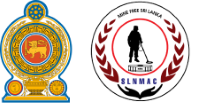Sri Lanka’s Mine Action Sector Gathers for Milestone Strategic Events Under Prime Ministerial Patronage

Sri Lanka’s Mine Action Sector Gathers for Milestone Strategic Events Under Prime Ministerial Patronage The National Mine Action Centre (NMAC), in collaboration with the Geneva International Centre for Humanitarian Demining (GICHD), successfully hosted a comprehensive series of high-impact events from 28 April to 2 May 2025. The week culminated in the Donor Coordination and Appreciation Ceremony presided over by the Honorable Prime Minister of Sri Lanka, Dr. Harini Amarasuriya, underscoring the national commitment to achieving a mine-free Sri Lanka. These milestone events were organized at the Galle Face Hotel, Colombo, and brought together key national and international stakeholders in a unified effort to take stock, assess progress, and define the path forward toward a mine-free Sri Lanka. 1. Completion Survey Stocktaking Workshop – 28 April 2025 The week began with a Completion Survey Stocktaking Workshop, jointly facilitated by NMAC and GICHD. Objectives included: Participants: Representatives from NMAC, GICHD, Regional Mine Action Offices (RMAO), operations and information management staff from operators (DASH, SHARP, HALO Trust, MAG), and Sri Lanka Army Humanitarian Demining Unit (SLA HDU). This technical session allowed for an evidence-based update that directly fed into the strategy review process, ensuring that forward planning is rooted in ground realities. 2. Mid-Term Strategy Review Workshop – 29–30 April 2025 The central event of the week was the Mid-Term Strategy Review Workshop, gathering a wide range of stakeholders across government, civil society, and international partners. Objectives of the review included: Participants: Country directors, programme and operations managers from implementing partners (DASH, SHARP, MAG, HALO), SLA HDU, Sri Lanka Campaign to Ban Landmines (SLCBL), and key government ministries including Defence, Foreign Affairs, Education, Environment, Health, Rural development and Social Security and Empowerment, Wildlife, and Finance & Planning. This forum reinforced collective ownership of Sri Lanka’s mine action strategy and positioned the country to move confidently towards timely completion. 3. Donor Coordination and Appreciation Ceremony – 2 May 2025 The week concluded with a landmark Donor Coordination and Appreciation Ceremony, attended by high-level dignitaries, including: Event Highlights: Stakeholders hailed the event as a strong demonstration of Sri Lanka’s continued leadership in mine action, especially in a global context marked by funding uncertainties. The unified message of the week emphasized collaboration, transparency, and evidence-based planning as essential pillars for the programme’s successful completion. A Call for Sustained Partnership The donor coordination meeting served as a platform to advocate for sustained and diversified funding and highlighted the vital role that international and national actors play in achieving the shared goal of a mine-free Sri Lanka. Discussions reaffirmed that, despite recent funding challenges, Sri Lanka’s Mine Action Programme remains resilient, unified, and strategically aligned with global best practices.
Field Visit by the Hon. Minister of Urban Development, Construction and Housing to Mine Action Sites in Mullaitivu – 24 April 2025
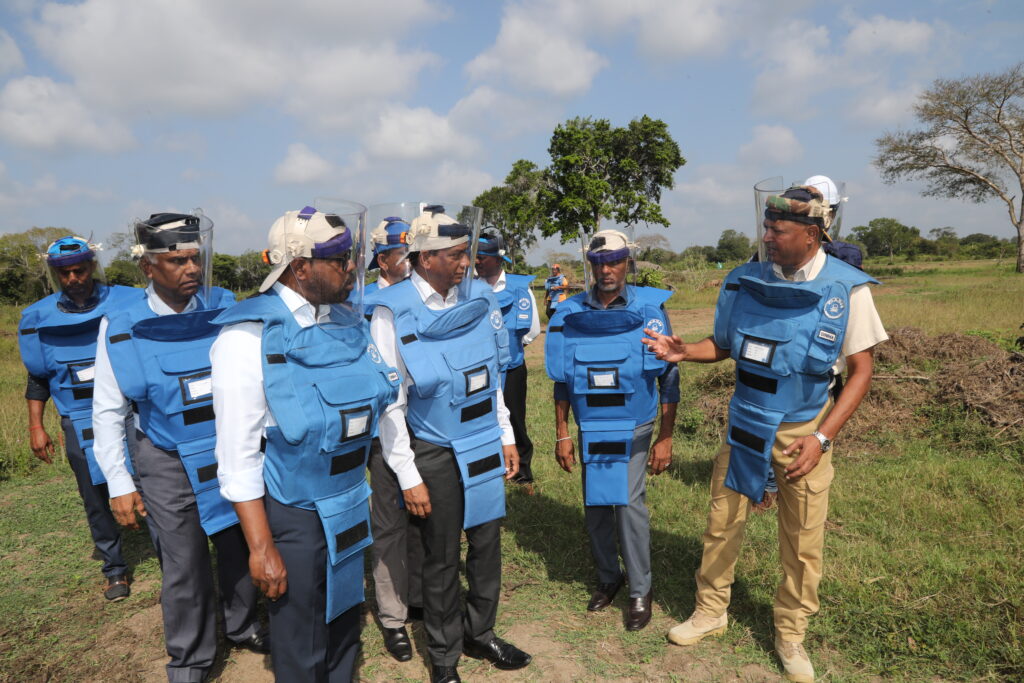
Field Visit by the Hon. Minister of Urban Development, Construction and Housing to Mine Action Sites in Mullaitivu The Hon. Mr. Anura Karunathilaka, Minister of Urban Development, Construction and Housing, conducted an official field visit to Mankulam in the Mullaitivu District on 24th April 2025 to observe ongoing humanitarian demining activities in the region.The Hon. Minister was accompanied by the Hon. Mr. T.B. Sarath, Deputy Minister; Mr. Ranjith Ariyaratne, Secretary to the Ministry; and Mr. M.M. Nayeemudeen, Additional Secretary and National Director. The demining site visited — Mullai Veedhi in Mankulam — is operated by Delvon Assistance for Social Harmony Sri Lanka (DASH), a long-standing partner in Sri Lanka’s mine action programme. During the visit, the DASH Programme Manager and Operations Manager provided a detailed briefing on operational progress, technical procedures, and safety protocols being followed in accordance with national Standard Operating Procedures (SOPs). In fact, the HALO Trust Programme Manager, Operations Manager, MAG Operations Manager, and SHARP Operations Manager also participated in the visit and expressed their contributions and suggestions for the way forward in the mine action programme. Also present during the visit were valuable deminers and other dedicated staff from DASH, who continue to work tirelessly in challenging conditions to clear landmines and explosive remnants of war (ERW). In addition, officers from the Regional Mine Action Office (RMAO) in Kilinochchi participated and contributed to the discussions on regional coordination and progress. Even 15 years after the end of Sri Lanka’s internal conflict, communities in the Northern and Eastern Provinces still face risks from landmines and ERWs. The Hon. Minister expressed deep appreciation for the courage and dedication of all personnel involved in mine action. “Although my visit lasted only a few hours, it left a lasting impression on me — of the magnitude of the challenge, the courage of the operators, and the resilience of the communities. I was deeply moved by the stories of individuals and families who live amidst the risk of hidden explosives. As a fellow Sri Lankan and as a responsible Minister, I am committed to doing everything within my capacity to ensure that they can live safely, with dignity and peace of mind.” The Hon. Minister also acknowledged the critical role of mine action partners in restoring land to safe and productive use and reaffirmed the full support of the Ministry of Urban Development, Construction and Housing in achieving a mine-free Sri Lanka by 2028. View Images – Field Visit by the Hon. Minister of Urban Development, Construction and Housing to Mine Action Sites in Mullaitivu – 24 April 2025
Celebration of International Mine Action Day

The International Day for Mine Awareness and Assistance in Mine Action is observed annually on April 4th. Established by the United Nations General Assembly in 2005, this day serves to raise global awareness of the dangers posed by landmines and explosive ordnance, and to promote efforts toward mine action and safety for all. This year, the National Mine Action Centre (NMAC) commemorated the day with a special event held at Athawetunuwewa National School in Welioya. The event was organized under the leadership of the National Director of NMAC, with the participation of the Divisional Secretary of Welioya, the Principal of Athawetunuwewa National School, the Area Commander of the Sri Lanka Army, and representatives from all mine action organizations operating in Sri Lanka. As part of the day’s activities, Explosive Ordnance Risk Education (EORE) sessions were conducted to educate schoolchildren on the risks of landmines and unexploded ordnance. The programme featured exhibitions, manual mine detection demonstrations, Demonstrator of Mine Detection using Dogs (MDD) and an awareness drama staged by the Sri Lanka Army’s Humanitarian Demining Unit. Contributions to the event were made by Sri Lanka Army, DASH, HALO Trust, MAG, and SHARP, showcasing their ongoing commitment to clearing mines and saving lives. In parallel with the awareness activities, and with the approval of the Chief Secretary of the Northern Province, an art competition was launched at Athawetunuwewa National School. Fifteen students took part in the opening event. The competition is open to all provincial schools in the Northern Province and will continue until April 24th, 2025. The best drawings, selected by an expert panel, will be recognized during the upcoming Donor Coordination and Appreciation Ceremony, to be held on May 2nd, 2025, under the esteemed patronage of the Honorable Prime Minister of Sri Lanka. Winners from three age categories will be appreciated for their creativity and contribution to mine action awareness. Through these initiatives, NMAC continues its commitment to creating a mine-free Sri Lanka, ensuring safety, education, and opportunity for future generation
Sri Lanka Participates in the 28th International Meeting of Mine Action National Directors and United Nations Advisers in Geneva

Mr. M.M. Nayeemudeen, the National Director for Mine Action, represented the Government of Sri Lanka at the National Directors Meeting held in Geneva from 8 to 11 April 2025. He was accompanied by officials from the Sri Lankan Embassy in Switzerland. During his visit, Mr. Nayeemudeen held discussions with donor representatives from German Federal Foreign Office (GFFO) to explore potential areas of support for Sri Lanka’s Mine Action Programme under the German Humanitarian Assistance. He also met with UN agencies, including UNICEF, to seek their continued assistance and engagement in mine action efforts across the country. A key highlight of his participation was the sharing of Sri Lanka’s success story in mine action, with a particular focus on the country’s Completion Strategy and Completion Survey process. These initiatives are central to achieving the country’s Article 5 obligations under the Anti-Personnel Mine Ban Convention by the target date of 1 June 2028. In addition, Mr. Nayeemudeen engaged with GICHD and various international mine action partners to share Sri Lanka’s experiences and discuss collaborative approaches to overcoming remaining challenges in the path toward completion. Discussions emphasized the importance of sustained support from donors and partners to address critical needs and ensure long-term success. During his visit, the following areas were highlighted through the media under the arrangements made by GICHD: How IMAS and NMAS have helped improve mine action in Sri Lanka; challenges and opportunities with standards In 2010, Sri Lanka developed its National Mine Action Standards (NMAS), aligned with the International Mine Action Standards (IMAS), through extensive consultations and collaboration with all mine action operators and relevant stakeholders. These standards cover all the areas such as land release processes, clearance methodologies (manual demining, mechanical clearance, battle area clearance), non-technical surveys, Explosive Ordnance Risk Education (EORE), Explosive Ordnance Disposal (EOD), Quality Management, and Marking of hazardous areas etc… These standards have significantly contributed to the effectiveness and consistency of mine action activities in Sri Lanka. They have enabled the programme to make informed and timely decisions on the ground and fostered a common understanding among government authorities, local and international stakeholders, and the donor community. Furthermore, the adherence to NMAS and was instrumental in Sri Lanka’s accession to the APMBC, which came into effect on 1 June 2018. The recently adopted Mine Action Completion Strategy 2023–2027 reflects a comprehensive approach to achieving Sri Lanka’s Article 5 commitments. One of the key achievements under this strategy has been the development of national standards for Completion Survey, enhancing the transparency and credibility of the land release process. As of now, out of approximately 1,400 GN divisions in suspected hazardous areas, 966 have been recommended for official declaration as cleared of mine and explosive ordnance (EO) threats. In order to achieve the obligations, The Completion Survey supports this goal by enabling consistent and transparent documentation of cleared administrative units. This demonstrates the Government’s commitment to applying All Reasonable Effort to identify and clear all mined areas, including anti-vehicle (AV) mines and explosive remnants of war (ERW), even beyond what is required under Article 5. In 2024, the Land Release, Non-Technical Survey (NTS), and Quality Management SLNMAS were developed in consultation with GICHD, following IMAS, to strengthen and expedite the land release process through clearance, cancellation, and quality management. In terms of current developments, NMAC, with support from GICHD, has requested technical assistance to review and update NMAS, particularly focusing on Explosive Ordnance Risk Education (EORE) and Information Management (IM). With the guidance of the GICHD IM Advisor, NMAC has drafted a new standard for Information Management to support the establishment of the IMSMA Core system in Sri Lanka. This is currently under review by GICHD. Challenges in implementing standards include: Ensuring that all operators consistently apply NMAS and IMAS in complex operational environments. Keeping standards updated in line with evolving technologies, methodologies, and contexts. Building capacity and awareness among field-level staff and local stakeholders to understand and use the standards effectively. Opportunities include: Strengthening national ownership and institutional capacity through standardized and transparent processes. Enhancing donor confidence and accountability through adherence to internationally recognized standards. Streamlining land release and clearance operations by improving coordination, information sharing, and data management under a unified framework. The NMAC has now established Technical Working Groups to review and implement the process in line with the new SLNMAS, in order to streamline mine action clearance and quality management activities. How has your work to have a national mine action strategy been beneficial for mine action in Sri Lanka? Sri Lanka’s National Mine Action Programme commenced in 2002 with the support of the United Nations Development Programme (UNDP). The National Mine Action Centre (NMAC), serving as the operational arm of the National Steering Committee for Mine Action (NSCMA), was officially established in July 2010. NMAC plays a central role in coordinating mine action activities on the ground and enables the Government to assume full ownership over the enforcement and monitoring of mine action policies and operations, contributing significantly toward a mine-free Sri Lanka. The first National Mine Action Strategy was developed in 2010, followed by a more comprehensive strategy in 2016, with technical support from the Geneva International Centre for Humanitarian Demining (GICHD). In 2023, the Mine Action Completion Strategy (2023–2027) was developed by NMAC with support from GICHD to guide the country in fulfilling its Article 5 obligations under the Anti-Personnel Mine Ban Convention (APMBC). This Completion Strategy (2023–2027) is built on four strategic objectives, all aligned with the vision that “Women, girls, boys, and men thrive in a mine-free Sri Lanka where explosive ordnance (EO) victims are fully integrated into society and have their needs met.” The Four Strategic Objectives: Land Release and Explosive Ordnance Risk Education (EORE):The release of safe land and implementation of inclusive EORE activities support completion and contribute to sustainable development. Coordination and National Ownership:Strengthened coordination and national ownership promote greater transparency, raise awareness, and encourage enhanced collaboration among stakeholders. Management of Residual Contamination:Residual EO contamination is addressed through sustainable national structures, ensuring
National Steering Committee Meeting on Mine Action – 28 February 2025
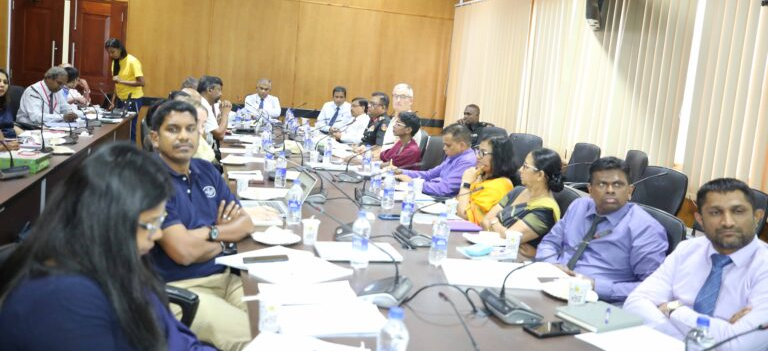
After several years, the Government of Sri Lanka (GoSL) convened the National Steering Committee Meeting on Mine Action on 28 February 2025, under the chairmanship of the Secretary of the Ministry of Urban Development Construction and Housing, with the National Director of Mine Action leading the discussions. This initiative has taken several steps to strengthen the mine action programme and address the challenges faced by demining organizations on the ground. Ms. Åsa Massleberg, Programme Manager and Senior Advisor for Strategic Planning at the Geneva International Centre for Humanitarian Demining (GICHD), attended the meeting and provided strategic insights on how the Sri Lanka Mine Action Programme can achieve its Article 5 obligations under the Anti-Personnel Mine Ban Convention (APMBC). She highlighted key challenges, including funding constraints and the discovery of unknown contamination during completion surveys, which can directly impact Article 5 obligations. Additionally, she reiterated GICHD’s commitment to working alongside Sri Lankan authorities in: The meeting was attended by high-level officials from the Ministry of Foreign Affairs, Ministry of Finance, Ministry of Health, Ministry of Social Services, Ministry of Environment, and the Department of Forests. All programme managers and representatives from Mine Action Organizations (HALO Trust, MAG, DASH, SHARP, SLA HDU) participated, along with Mr. Vidya Abhayagunawardena, Coordinator of the Forum on Disarmament and Development (FDD), Sri Lanka, and Mr. Prasanna Kuruppu, an Independent Researcher/Consultant on Disability Affairs. All key officials from the Ministry, NMAC, and RMAO were also in attendance. Key Points Highlighted by the National Director All mine action operators (HALO Trust, MAG, DASH, SHARP, SLA HDU) presented their contributions to Sri Lanka’s mine action programme, highlighting progress, challenges, and recommendations for the way forward. Key Points from Representatives Ministry of Foreign Affairs & UN Department Ministry of Environment & Department of Forests Ministry of Health Ministry of Social Services Ministry of Finance Remarks by Mr. Vidya Abeygunawardana Mr. Vidya Abeygunawardana emphasized the following key areas of discussion:
Meeting With Country Directors/Programme Managers
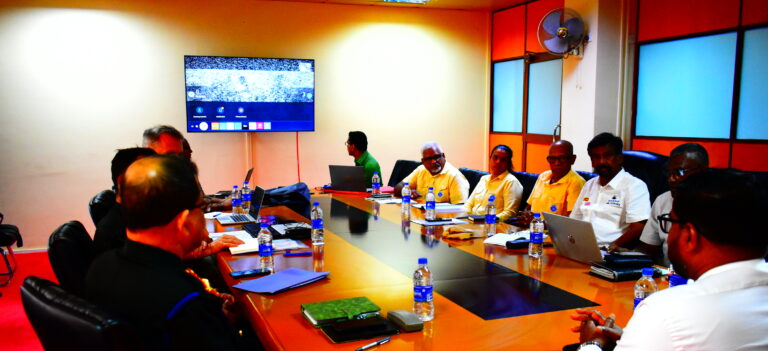
A special meeting was conducted under the Additional Secretary (Projects/National Director of Mine Action) on 30th January 2025 at 10.00am at the Ministry of Urban Development, Construction and Housing to discuss the Action Plan 2025, current situation of the Sri Lanka Mine Action Programme, and affect due to the temporary freeze of US donor funds from 24th January 2025. temporary freeze of US funds has severely impacted the Mine Action Programme in Sri Lanka, particularly in achieving the expected clearance targets for this year. At the meeting, we focused on streamlining Mine Action activities in alignment with the Sri Lanka Mine Action Strategy through a results-based Action Plan for 2025. The Deputy Director, Chief Field Engineer from the Sri Lanka Army, along with senior Sri Lanka Army officials, all Programme Managers from HALO Trust, DASH, SHARP, and the Country Director from MAG, and key officials from their respective organizations, NMAC officials, and the IM Specialist from GICHD/NMAC, participated in the meeting. The following key decisions were made during the meeting · Execute immediate awareness for the Minister of the Ministry of Foreign Affairs and organize a high-level discussion · Organize a donor meeting immediately under the Minister of this Ministry, involving all current donors and potential new foreign delegations. · All issues that cannot be resolved at the Operational and Review stages will be taken to the National Steering Committee (NSC) meeting under the Secretary of this Ministry. · Organize a high-level event during International Mine Action Week in April, inviting key officials and delegations. · Enhance communication on mine action activities by sharing updates through the website and social media platforms.
IMSMA Core Implementation, July 2024
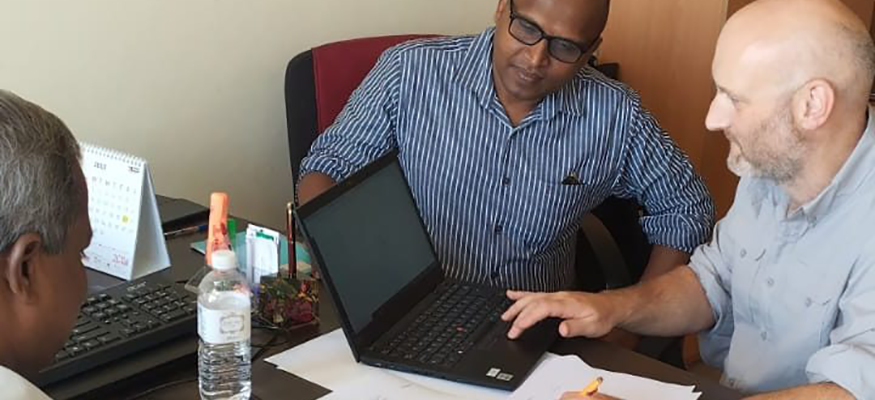
IMSMA Core, a system built on Geographic Information Systems (GIS) software, provides a flexible suite of tools and processes tailored to meet the specific operational and reporting needs of national mine action programs, including Sri Lanka’s.
Supporting Sri Lanka’s Path to Completion: GICHD’s Workshops, June 2024
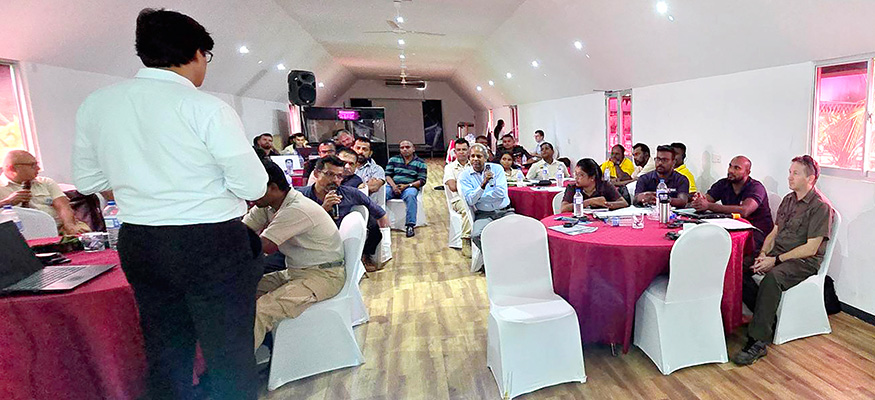
As part of ongoing efforts to assist Sri Lanka in implementing its completion strategy for mine action, the Geneva International Centre for Humanitarian Demining (GICHD) facilitated three pivotal workshops in June 2024.
International mine awareness day in Kilinochchi
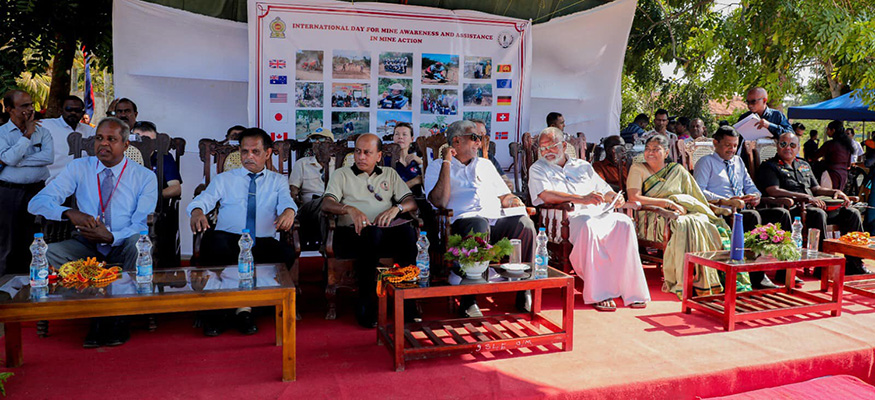
To commemorate International Mine Awareness Day, the National Mine Action Center (NMAC) along with MAG, HALO, DASH, SHARP and the Sri Lanka Army Humanitarian Demining Unit participated in a friendly cricket match in Kilinochchi public ground on the 6th of April.
